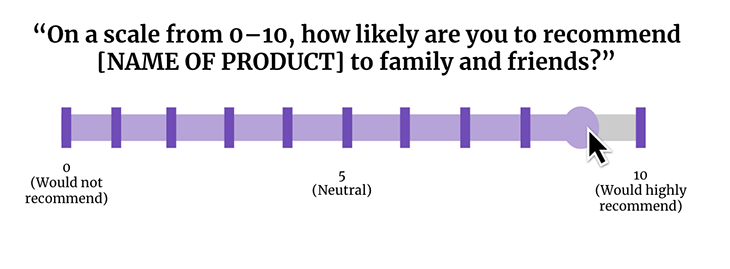A key indicator of product success is how the customer feels about using the product to do what they need. It not only tells you whether the product has achieved product-market fit, but is also a telling sign of the longevity past the initial acquisition and activation stage.

As a product manager, it is your responsibility to understand customer sentiment — both good and bad — when it comes to using your product. It’s also your responsibility to quantify this sentiment in a way that gives you and your team a clear goal.
There are a number of different ways to quantify customer satisfaction, but the one that we’ll cover off today is customer satisfaction score (CSAT) — a simple yet effective indicator of customer happiness and loyalty when it comes to using your product.
As the name suggests, the customer satisfaction score (CSAT) is a quantitative measure of how satisfied the customer is with using the product. It also measures their satisfaction with the overall service provided for by the product, such as customer support, helpful documentation, and time to issue resolution.
CSAT helps companies and teams to not only determine whether they are on the right path in developing new and exciting features for the product, but also provides a leading indicator of success. The closer the score is to 100, the better.
As a leading (and not a lagging) measure, teams are able to justify new features or functions in the product by watching the CSAT rise or fall after release. This gives them a sign of whether customers are increasingly more satisfied, or just maintaining a baseline level of satisfaction when it comes to shipping new features and functions.
Calculating CSAT is easy — you just need to ask the question and then divide the number of positive responses by the total number of responses, and then multiply by 100. We’ll break it down further below.
The beauty of CSAT lies in its simplicity. First, a singular question asked to the customer. This question can be asked within the product or outside of it, and can be provided contextually as part of something that either they are doing in the product or as a result of an interaction that they had (e.g., submitting a support ticket).
A good example of a CSAT question is:
“How would you rate your overall satisfaction with the product or the service that you received?”
Customers are then asked to provide their response via a range of 1–7, with 1 being “Very unsatisfied” and a 7 being “Very satisfied:”

After gathering answers from customers to that question, it’s time to calculate the score. This is fairly easy to do, the formula is:
(Number of positive responses / Total number of responses) * 100
Positive responses lie between the range of 5-7 on the CSAT question. For example, let’s say you received a total of 100 responses and 40 of them are positive. The calculation would be:
(40/100) * 100 = 40%
The CSAT score is 40 percent (which isn’t very good and gives you an indicator that things need to change!).
Like other metrics, what constitutes a “good” CSAT score will depend on the industry. 100 is the highest possible score, so generally, a good CSAT score is 75 percent or higher. Anything above 85 percent is considered excellent.
There are two other equally popular customer engagement and happiness measures aside from CSAT that are worth covering here — NPS and CES. A team might choose to use one or the other for certain things.
The following are the ways in which CSAT, CES, and NPS differs from one another:
CSAT is a measure of the customer’s satisfaction not only with using the product, but also just with the product on a holistic level (e.g., level of customer support, helpful documentation, time to issue resolution, etc.)
Customer effort score, or CES, measures the amount of effort that a customer puts into completing a certain task or to using a certain feature with the product.
A CES statement typically looks like this:
“[NAME OF COMPANY] made it easy for me to [NAME OF JOB TO BE DONE].”
The answer to the above statement is then ranked on a 1–5 scale — 1 being “Strongly disagree” and 5 being “Strongly agree:”

The higher the CES score, the better. This means the customer is not exerting a ton of effort to use your product.
NPS, also known as net promoter score, is slightly similar to CSAT but leans more towards figuring out customer loyalty and retention with your product.
An NPS statement looks like this:
“On a scale from 0–10, how likely are you to recommend [NAME OF PRODUCT] to family and friends?”

The higher the NPS score, the better — this means the customer is keen to refer your product because of their overall enjoyment and satisfaction when using it.
| Metric | Description | Typical question | Scoring method | Goal |
| CSAT (customer satisfaction score) | Measures a customer’s satisfaction with the product itself and on a holistic level with things like product interactions or customer support | Varies depending on the specific aspects being measured | Likert scale, usually 1–7, 1 being “Very unsatisfied” and 7 being “Very satisfied” | To assess overall satisfaction with the product and the associated context |
| CES (customer effort score) | Measures the amount of effort that a customer puts into completing a certain task or using a certain feature with the product. | “[NAME OF COMPANY] made it easy for me to [NAME OF JOB TO BE DONE].” | Ranked on a 1–5 scale, 1 being “Strongly disagree” and 5 being “Strongly agree” | To find how easy it is to use the product |
| NPS (net promoter score) | Measures customer loyalty and retention with your product. | “On a scale from 0–10, how likely are you to recommend [NAME OF PRODUCT] to family and friends?” | 0–10 scale, with 10 indicating the highest likelihood of recommendation. | Measures the willingness of customers to refer the product to their friends or family |
All three of these measures are popular because they’re effective ways of gauging customer interest and satisfaction with the product. They’re all simple to implement too, as each measure only requires one question and a range of scores to choose.
The following are the advantages to using CSAT as a key indicator of customer happiness with the product:
As mentioned previously, many teams favor CSAT because of its ease and simplicity in both application and implementation. As it’s just a singular question that needs to be asked to customers, only the method of delivering that question that needs to be contemplated — whether it’s done within the product (as a pop-up) or outside of the product (like in an email).
Not only is it easy to implement, but it’s also easy to record the results and use them immediately as a gauge for customer happiness. Answers are recorded on an easy scale and the calculation of the score is easy too.
CSAT is also a useful measure when determining if the product is delivering the right value to the customer, or if the interactions the customer has is leading them down the path of success.
As mentioned previously, the question can be asked in a number of different settings (e.g., after completing a task in the product or as a wrap-up to a customer success or support call) and delivered in a number of different ways.
As such, it can be used to gauge customer satisfaction on a variety of different things in the product, and can help multiple teams determine if the processes or features they have in place help the customer achieve their goals and remain happy with the product.
Finally, due to all of the above reasons, CSAT scores can be used as a key result. This is especially beneficial for teams whose objective revolves around customer happiness and satisfaction, such as customer support teams or support engineers, or even for product teams where customer satisfaction is a KPI.
The score can be gathered as input after the successful trial and launch of an MVP to determine if customers are enjoying the first iteration of the feature, or if more work is required.
Additionally, the score can also be gathered over the course of the year and framed in a general sense of happiness in using the product. This can then fuel future initiatives or as evidence that the product is working as intended.
As product managers, it is important to use every and all input when it comes to product use, retention, and customer satisfaction to your advantage.
Those three broad categories of customer engagement with the product will not only help inform your team that they are on the happy path towards product success and market fit, but also help you determine the current and future roadmap.
There are two key ways to effectively use CSAT as a product manager:
As mentioned before, a product manager can utilize these advantages to ask a CSAT question for existing or future initiatives. This can help determine whether or not an existing pain point needs fixing or if a greenfield opportunity presents itself.
As feature iterations are pushed out or initial MVPs are released, it is important to continuously pulse-check customer sentiment so that the team is confident that they are pushing out the right features. CSAT can be a signal to either continue with development work or pause entirely to determine a new direction if customer sentiment turns negative instead.
Finally, if you continuously calculate CSAT scores throughout the year, the rise or fall of the overall CSAT over that time can be a useful indicator for determining if customer satisfaction is turning sour.
At this point, the CSAT can be a trigger point — determining whether there is something urgent requiring a fix to improve customer sentiment or if there are new and exciting trends the customer wants but doesn’t have.
Follow the tips above and you’ll be on your way implementing and using CSAT like a product manager in no time. Until next time!
Featured image source: IconScout

LogRocket identifies friction points in the user experience so you can make informed decisions about product and design changes that must happen to hit your goals.
With LogRocket, you can understand the scope of the issues affecting your product and prioritize the changes that need to be made. LogRocket simplifies workflows by allowing Engineering, Product, UX, and Design teams to work from the same data as you, eliminating any confusion about what needs to be done.
Get your teams on the same page — try LogRocket today.

A practical framework for PMs to use AI in ideation without sacrificing judgment, strategy, or decision quality.

A practical five minute revenue estimation method to help product managers compare ideas, drop low impact features, and prioritize smarter.

A practical guide for PMs who want to stop being bottlenecks, delegate smarter, and lead teams effectively with a clear ownership framework.

Stop letting unreliable data block features. Treat data as inventory to track quality, ownership, and ship with confidence.